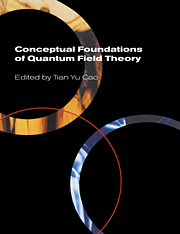Book contents
- Frontmatter
- Contents
- List of contributors
- Preface
- Photographs of the conference
- Introduction: Conceptual issues in quantum field theory
- Part One Philosophers' interest in quantum field theory
- Part Two Three approaches to the foundations of quantum field theory
- Part Three
- Part Four Mathematics, statistics and quantum field theory
- Part Five Quantum field theory and space-time
- Introduction
- 12 Quantum field theory and space-time – formalism and reality
- 13 Quantum field theory of geometry
- 14 ‘Localization’ in quantum field theory: how much of QFT is compatible with what we know about space-time?
- 15 Comments
- Part Six
- Part Seven Renormalization group
- Part Eight Non-Abelian gauge theory
- Part Nine The ontology of particles or fields
- Part Ten
- Name index
- Subject index
13 - Quantum field theory of geometry
Published online by Cambridge University Press: 22 September 2009
- Frontmatter
- Contents
- List of contributors
- Preface
- Photographs of the conference
- Introduction: Conceptual issues in quantum field theory
- Part One Philosophers' interest in quantum field theory
- Part Two Three approaches to the foundations of quantum field theory
- Part Three
- Part Four Mathematics, statistics and quantum field theory
- Part Five Quantum field theory and space-time
- Introduction
- 12 Quantum field theory and space-time – formalism and reality
- 13 Quantum field theory of geometry
- 14 ‘Localization’ in quantum field theory: how much of QFT is compatible with what we know about space-time?
- 15 Comments
- Part Six
- Part Seven Renormalization group
- Part Eight Non-Abelian gauge theory
- Part Nine The ontology of particles or fields
- Part Ten
- Name index
- Subject index
Summary
Introduction
Several speakers at this conference have emphasized the conceptual difficulties of quantum gravity (see particularly [1-3]). As they pointed out, when we bring in gravity, some of the basic premises of quantum field theory have to undergo radical changes: we must learn to do physics in the absence of a background space-time geometry. This immediately leads to a host of technical difficulties as well, for the familiar mathematical methods of quantum field theory are deeply rooted in the availability of a fixed space-time metric, which, furthermore, is generally taken to be flat. The purpose of this contribution is to illustrate how these conceptual and technical difficulties can be overcome.
For concreteness, we will use a specific non-perturbative approach and, furthermore, limit ourselves to just one set of issues: exploration of the nature of quantum geometry. Nonetheless, the final results have a certain degree of robustness and the constructions involved provide concrete examples of ways in which one can analyze genuine field theories, with an infinite number of degrees of freedom, in absence of a background metric. As we will see, the underlying diffeomorphism invariance is both a curse and a blessing. On the one hand, since there is so little background structure, concrete calculations are harder and one is forced to invent new regularization methods. On the other hand, when one does succeed, the final form of results is often remarkably simple since the requirement of diffeomorphism invariance tends to restrict the answers severely.
- Type
- Chapter
- Information
- Conceptual Foundations of Quantum Field Theory , pp. 187 - 206Publisher: Cambridge University PressPrint publication year: 1999
- 1
- Cited by



